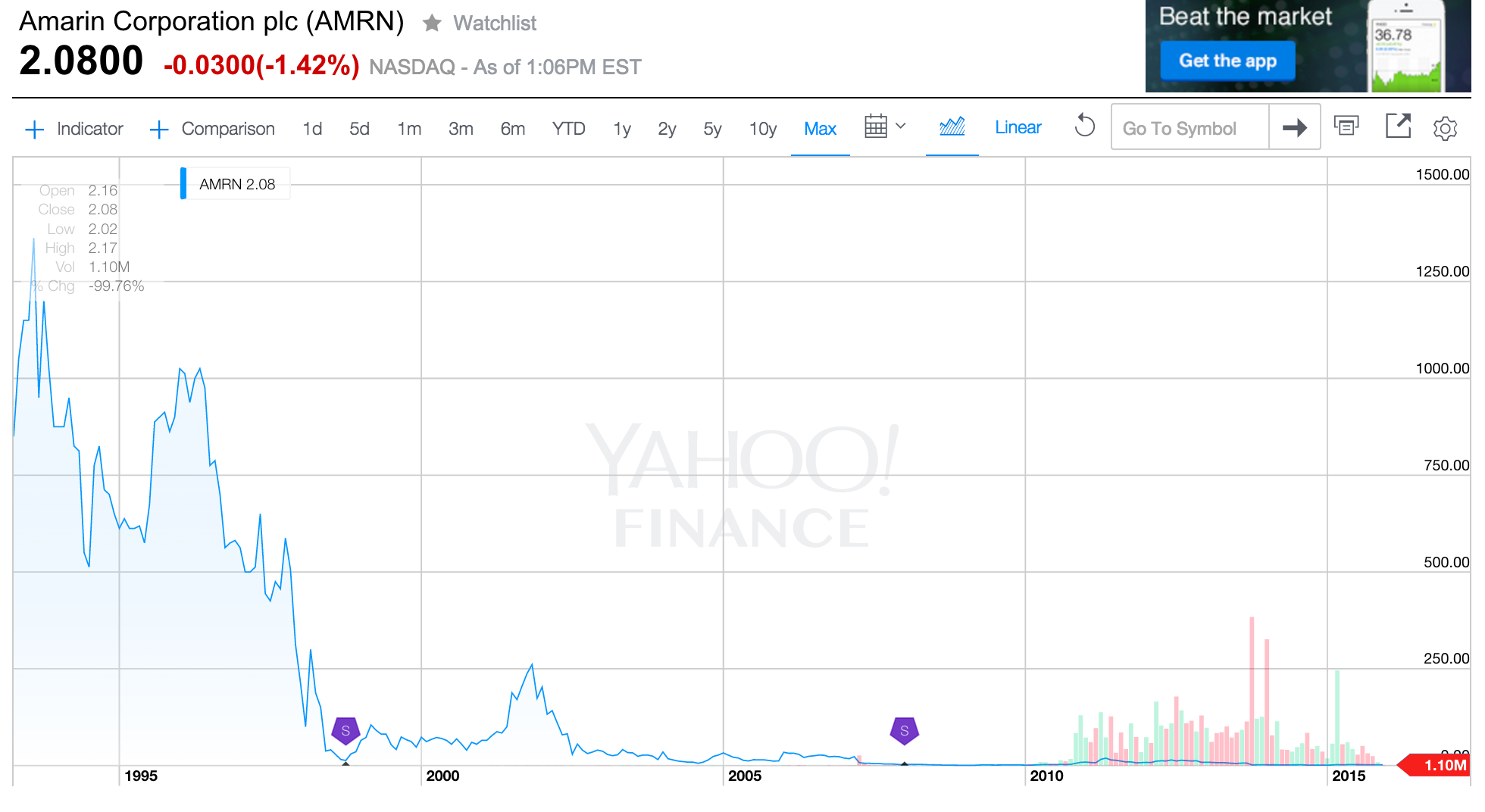Trade Alert: A new biotech/pharma/pot short PLUS why I’m selling WFM

Two Trade Alerts today.
New biotech/pharma/marijuana stock short idea.
This market has entered a “No BS” phase. If there’s a whiff of BS in a company’s business model, it’s likely to get crushed and crushed again. Companies like Valeant or $MNK which have been at best aggressive in their accounting get demolished as traders and shortsellers and long investors alike sell first and ask questions later. I’ve talked recently about how the market is a winners-take-all and that the losers just keep losing, calling this a “Tale of Two Markets” dynamic. Most of winners are at or near 52-week highs and most of the losers are at 52-week lows. Notice I said “most” because we can still find some exceptions to the rule that are likely to fall in line with the “Tale of Two Markets” dynamic as this “No BS” phase continues.
Which leads me to a new short for the portfolio, in the name of GW Pharmaceuticals. GWPH is known as the “safe” marijuana pure play stock. But there a plenty of red flags around this name and the valuation is so whacky that it will take an extreme “best case scenario” playing out for this company to make shareholders money in the next five years. First, the red flags. The company came public using reverse merger, in which it bought a shell of a formerly publicly-traded company whose shares still sat on an exchange in Great Britain where it’s based back in 2001 to the London AIM exchange (equivalent to U.S. OTC market listing) and later listed its American Depository Shares on the NASDAQ on 05/01/13 as an ’emerging growth company’ under the relaxed regulatory requirements of the JOBS Act at only $8.90/share.
Reverse mergers are often a way for seedy companies and executives and financiers to fleece retail investors and any company that comes public in a reverse merger should be scrutinized extra hard. I was curious about the founders, Chairman and CEO of this company so I went straight to their bios on the company’s website where I found:
“Dr. Geoffrey Guy is our founder and has served as our Chairman since 1998. Dr. Guy has over 30 years of experience in medical research and global drug development, most recently as Chairman and Chief Executive of Ethical Holdings plc, a Nasdaq-quoted drug delivery company (now Amarin Corporation plc, or Amarin), which he founded in 1985 and led to its Nasdaq listing in 1993. He also founded Phytopharm plc in 1989, of which he was Chairman until 1997.”
“Justin Gover has served as our Chief Executive Officer since January 1999. He has 17 years experience in the pharmaceutical industry. Prior to joining our company, Mr. Gover was Head of Corporate Affairs at Ethical Holdings plc from 1995 to 1997 where he was responsible for the company’s strategic corporate activities, including mergers and acquisitions, strategic investments, equity financings and investor relations.”
So went and looked up this Ethical Holdings plc, a Nasdaq-quoted drug delivery company (now Amarin Corporation plc, or Amarin), which both of these two top executives of the company came from. Ethical holdings was a microcap penny stock back 1999 trading under the symbol ETHCY and its stock has done two reverse 1-for-10 splits since then, changed its corporate name to Amarin and stock symbol to AMRN and is down 99% since then.

Beyond just disappointing trial results thus far, the crux of the issue is that GW’s stock is currently trading at 4 times its estimated 2019 revenue (according to data provided by S&P Capital IQ), and almost all of this revenue is expected to come from products that are still in clinical trials.”
Meanwhile, the company’s drug trials for Sativex are going terrible. There’s not much real news about how the Epidiolex trials have been going though there has been and still is still a lot of hype around the Epidiolex trials.
GWPH is rated BUY by the Wall Street sellside brokerage analysts, as 5 out of 5 of them have positive ratings on the stock with an average $143.40 Target Price on GWPH. I’ll take the other side of their analysis here and start building a short position in this name.
To be sure, this stock could pop and rally 50-100% on the hype it would receive if Epidiolex does end up getting approved and becoming a viable treatment. I wouldn’t be surprised to see some mainstream drugs based on marijuana-derivatives and although my sources in the pharma industry are less than sure that any such marijuana-based drugs would be able to be defended against generics anyway, that doesn’t mean this stock couldn’t run back towards its all-time highs it reached this past summer when the stock was in the $120s.
There are enough red flags along with the company’s insanely high valuation metrics to make me think this “No BS” market is going to bring this stock back down to Earth sooner rather than later. I’m starting with a 1/3-sized short common stock position in this name today.
I know that some of you guys are going to ask me if there are some puts on this stock to look at and I’ll answer that here too. The premiums on the GWPH puts are rather high, as the stock is very volatile anyway. I’d probably look to go out at least a year on the expiration, which would then point us to the January 2016 puts. Even going down $20 below the current quote, the January 2016 puts with the $65 strikes will cost your $15 which means the stock would have to fall below $50 for those strikes to get in-the-money. The in-the-money puts have very high premiums too. So for now I’m just using shorting a few shares of GWPH common stock to get started.
Selling Whole Foods
Whole Foods is about to screw up their balance sheet and I’ve got no choice but to move on from this stock as a matter of discipline. Whole Foods generates a half a billion dollars a year in cash flow and was using that money to invest in their future, grow the cash on the balance sheet and pay a small dividend. The company’s most recent earnings report last week was bad on a lot of levels, including the fact that the company’s comparable stores dropping 0.2% instead of growing. Gross margins came down. But the kicker for me and the reason I’m selling this stock is because the company now wants to take the cash they have on the balance sheet and borrow a billion dollars more to buy back shares. Read the details for yourself:
“The Company’s Board of Directors has authorized a new $1 billion share repurchase program, bringing the Company’s total share repurchase authorization to $1.3 billion…Prior to the end of the first quarter, the Company intends to incur additional long-term debt of up to $1 billion….Proceeds from any debt incurred would be used for general corporate purposes, including the repurchase of stock. The Company’s intent is to spend the majority of the $1 billion buyback authorization in the first half of the fiscal year and expects the combined effects of the additional indebtedness and future share repurchases to be accretive to earnings per share in fiscal year 2016.”
When I bought Whole Foods back a few weeks ago, I wrote “Whole Foods has almost no debt and almost a billion dollars in net cash.The company’s bar is set lower with analysts expecting 8% revenue growth.” Now the company’s wiping out the financial flexibility they had with their $1 billion net cash and wasting shareholder money on huge stock buybacks and revenue growth estimates are still down.
Why am I such a stickler for finding strong balance sheets and focusing on financial flexibility for the stock I invest in? Look at all the bankruptcies going on in the energy sector right now, including MHR’s crashing stock and news today. Look at Nortel and Lucent both of which had billions in debt and which crashed 100% to bankruptcy and 99% to penny stock status respectively. Look at the Too Big To Fail banks back in the 2008 financial crisis and the trillions of dollars of bailouts it’s taken to keep them afloat since then. Executives at these giant corporations who borrow billions to distribute to shareholders, buyback stocks and enrich themselves, just because they can need to take some Dave Ramsey courses.
I bought Whole Foods to invest in a Healthy Eating Revolution, not to to risk my money on Whole Foods’ financial engineering and balance sheet-wrecking moves. I’m selling my Whole Foods today and removing it from my stock screen as I don’t even want to look at this ticker any more.

